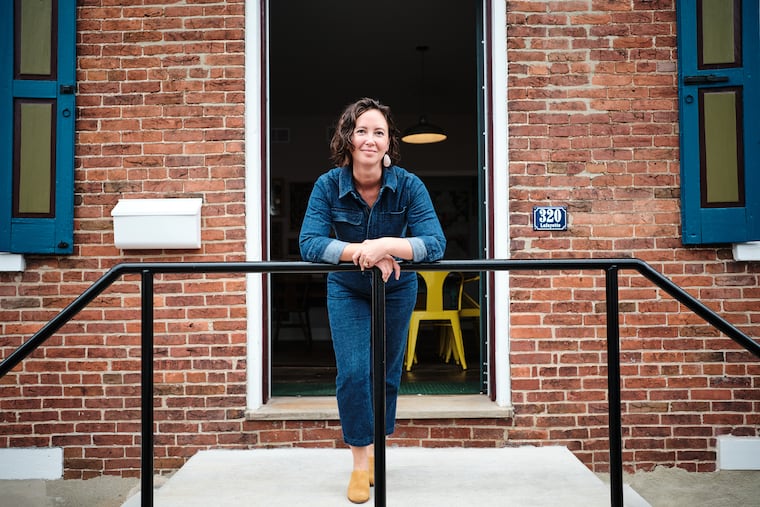An artist residency and boutique hotel spring from an old factory in ‘Upstate Pennsylvania’
Painter Maria Stabio opened a boutique hotel and artist residency after moving from New York City to Schuylkill County.

All Maria Stabio wanted was a big, affordable building where she could make art.
A painter formerly based in Brooklyn, Stabio knew Upstate New York, a longtime arts hub for folks in the city, was out of the question, financially. So, like a growing number of artists, she looked west, to Northeast Pennsylvania, with its dozens of postindustrial vacancies, old, shuttered mills, and empty churches and barns, and she found herself a cavernous schoolhouse in Barnesville, Schuylkill County, for $43,750.
“If that were in the Hudson Valley, it could have sold for, I don’t know, maybe a half-million dollars,” Stabio said.
Stabio settled in to renovate the schoolhouse and create more art and, eventually, started renting out a portion of the building on Airbnb. She didn’t plan on buying a second, even larger, old building, or being tapped to help transform a former Schuylkill County coal town into a place people want to visit and invest in. But that’s what happened — and now the 19th century Conrad Bischoff Planing Mill and Furniture Factory in downtown Tamaqua features a small, stylish boutique hotel and artist micro-residency.
The website for the Bischoff Inn, which has five rooms, a communal area, coffee bar, original brickwork, and planked floors, mentions that it’s “located in the heart of upstate Pennsylvania,” a nod, perhaps, to that better-known upstate north of New York City, with a twist.
“It’s just as close and more convenient and it’s much cheaper,” she said.
The space to create
Stabio is an artist first and foremost, so when the folks at Tamaqua’s City Revitalization and Improvement Zone (CRIZ) approached her (and offered her a loan for the $1.1 million project) about buying and redeveloping the Bischoff, she knew she wanted to bring fellow artists into town, through a residency program. Most artists and many writers thrive on residencies, she said, as an escape from the routine, a way to have space and time to create.
“It’s a vital part of being an artist,” she said.
On this weekday afternoon, textile and fabric artist Kaylan Buteyn had dozens of pieces of colorful fabric spread across the floor of a large, two-story lumber shed behind the Bischoff, which serves as the studios for the residents. Buteyn, 37, of Fort Wayne, Ind., has three children, and getting a week to immerse herself in her art, she said, is priceless.
“I wanted a nice place to stay, you know, a place that was short-term and as an artist parent, I’m not gonna go away from my kids for a month,” Buteyn said. “I don’t want to and also I can’t do that. I was just so thankful for the space because, you know, I have a studio that’s probably like a third of this floor space.”
Stabio has had funding and donations for the scholarship residencies, but she said fundraising for the residencies would be a full-time job of its own. Buteyn paid $370 to stay for a week.
“We just got started but I’d like to get more donations and funding,” Stabio said.
Pennsylvania is home to other artist residencies, including the 550-acre Lacawac Sanctuary in the Poconos and the Soaring Gardens Artists Retreat in Laceyville, Susquehanna County.
New York City painter Jessica Dalrymple, who specializes in nature themes, stayed at the Soaring Gardens residency in 2017 for its remote, rural location.
“It was a word of mouth kind of thing and the pictures looked beautiful,” she said. “It was just me there and it was so much space and the windows were huge and looked out onto farms. It’s fun to remember because those opportunities to focus on my work like that are rare.”
An artist residency trend
In recent years, other artists like Stabio have ventured out into Pennsylvania’s hinterlands too, from New York, and created residencies and odd, rural art destinations.
Comedian and cartoonist Emily Flake looked to Williamsport as an escape from the city during the COVID-19 pandemic and wound up buying an old, stately home there and turned it into the St. Nell’s Humor Residency. She hosts comedy shows in the Lycoming County city.
“I feel like everybody who lives in New York has a dream of opening an artist or writer’s residency or moving upstate and buying goats,” Flake told The Inquirer in 2022. “I don’t think I’d be good at goat husbandry, so writer’s residency it is.”
In Pottsville, just 16 miles west of Tamaqua, artist Lance Rautzhan returned to his family’s Christmas tree farm, via Brooklyn, and opened a tiny art “cabin” where he regularly hosts shows and gatherings. He said rural Pennsylvania can embrace a different, weirder arts vibe, perhaps, than Upstate New York, and it can be its own vibe.
“It’s not the same kind of rural,” Rautzhan told The Inquirer last year. “You can hop on a train in New York City and get upstate. You can’t do that here.”
In Tamaqua, Stabio is urging people to invest in small businesses, to ride the town’s beloved train (it goes to scenic Jim Thorpe), and embrace “upstate Pennsylvania.” Local business leaders are glad she did.
“Maria is one of those people who chose Tamaqua and we’re very lucky she did,” said Eric Zizelmann, a funeral director who is related to the original Bischoffs.
Stabio’s right about choosing Schuylkill County over the Hudson Valley, too. A schoolhouse there, about half the size of hers, recently sold for $725,000.